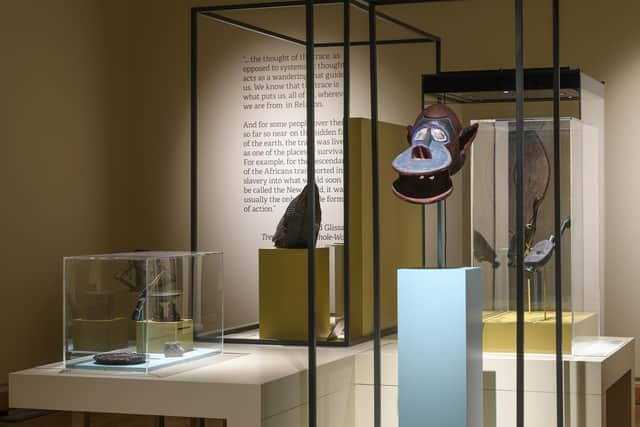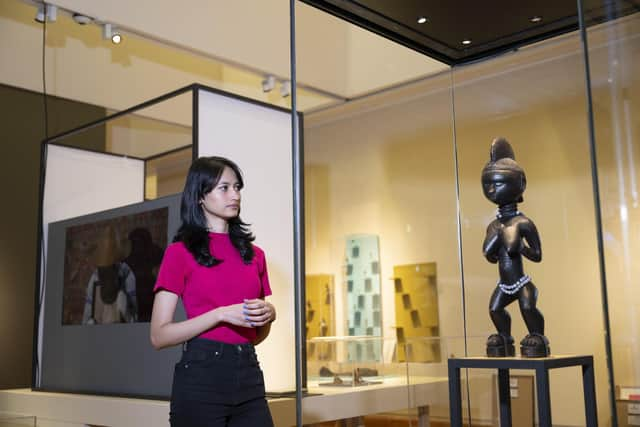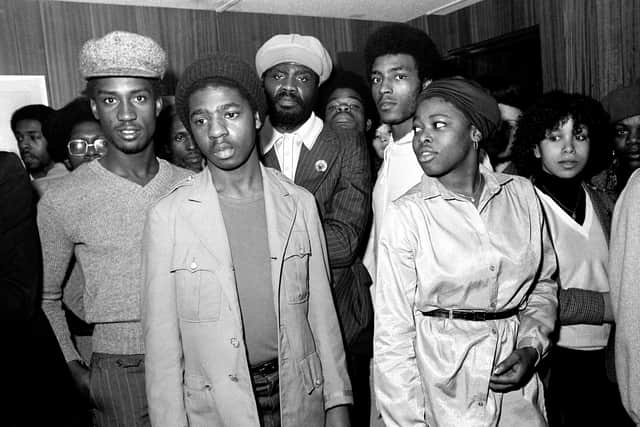Art reviews: The Trembling Museum | Café Royal Books
The Trembling Museum, Hunterian Art Gallery, Glasgow ****
Café Royal Books, Stills, Edinburgh ***
Western museums are increasingly uncomfortable about their collections of African art. Faced with tricky questions about how to present and interpret them in a post-colonial world, many seem to have concluded that it’s safer not to. Let the objects stay in the stores, and perhaps people will forget we’ve even got them.
The Trembling Museum is a bold attempt by curators at Glasgow’s Hunterian to take some of their African treasures out of the store rooms and explore contexts in which they can be shown. Curator of World Cultures, Andy Mills, and Curator of Contemporary Art, Dominic Paterson, invited Malian writer and filmmaker Manthia Diawara and art historian Terri Geis to help propose a framework for an exhibition.
Advertisement
Hide AdWending one’s way through the Whistlers, past the Rembrandt, one reaches a moderately sized show full of big ideas; a series of striking objects beautifully displayed on free-standing units. Trembling Museum’s ambitious premise is to present the African objects – drawn from a range of countries and cultures and time periods – as art, not ethnography, and show works of contemporary art in conversation with them.
The guiding principles come from Martinican poet and thinker Edouard Glissant (1928-2011) who pioneered the concept of “trembling” (in French “tremblement”): as old orders pass away, the world is in flux. Definitions can’t be pinned down, identities are multiple. Can a museum – by its nature something that defines and classifies and preserves – also “tremble”?
There is no sense, Glissant contends, in harking back to an idea of a “pure” African culture: the messy history of colonialism and the slave trade has put paid to that. At the same time, it isn’t especially helpful to draw dividing lines between utilitarian and ritual objects, between making and creating. Objects, textiles, masks and statues carry ideas, meanings and metaphors much as western works of art do. Why not just call it art?


Some of the objects here particularly reflect that state of flux: fabric dyed in Nigeria in the 1980s with a pattern invented in 1935 to mark King George V’s jubilee; African designs stencilled on Asian polyester; thornwood figures depicting village life in Nigeria made for the tourist market; Christian icons painted in Ethiopia influenced by the Eastern Orthodox tradition.
At the same time, works by contemporary artists echo Glissant’s ideas: Leo Robinson’s construction Untitled (Oracle 1) is a collage of fragments, part divination tool, part board-game. Jimmy Robert questions some of the foundations of western art by reminding us that what we think of as pristine white Greek statuary was actually painted, sometimes to convey dark skin. Prints by Lubaina Himid and Alberta Whittle engage with ways of reimagining the colonial past.
Ulrike Ottinger and Adam Pendleton are concerned with performance – a redolent theme among the masks, costumes, musical instruments. Ottinger animates the collection of African figures she inherited from her father in Still Moving, a film to which she adds further layers: photographs from her archive and footage of a Kabuki play she directed. Pendleton creates a portrait of dancer and choreographer Yvonne Rainer, asking her to read a collaged text which includes excerpts from her memoir as well as descriptions of incidents in which black men were shot by American police.
Advertisement
Hide AdGlissant’s “trembling” metaphor of a volcano or earthquake is embodied by references to an actual volcano – the catastrophic eruption of Mount Pelée in Martinique in 1902. Diawara and Geis were surprised to find in the Hunterian collection a broken rooftile from St Pierre fused with ash from the eruption. It takes pride of place, and other samples of volcanic rock appear throughout the show.


There are two further fascinating films shown among the objects: You Hide Me, made in 1970 by Ghanaian filmmaker Nii Kwate Owoo in the British Museum, in which he pulls no punches about the despicable record of western countries with regard to African cultural history and demands – in a way which seems as relevant now as it did 50 years ago – that their treasures be returned. Statues Also Die, made in 1953 by Chris Marker and Alain Resnais, a winner of the Prix Jean Vigo in France in 1954, makes a passionate (and early) argument for understanding these objects as art.
Advertisement
Hide AdThe interweaving of African and contemporary art isn’t entirely successful. The African objects dominate the show not only in numbers but in their visual power, and they are accompanied by such informative labels that they begin to look more like ethnographic exhibits than the curators very likely intend. Perhaps the volcano metaphor is a little too laboured. Perhaps there is just too much here, particularly if one wants to watch all the films.
That said, The Trembling Museum is a superbly ambitious take on one of the thorniest issues in the museum world, addressing it in a creative, sensitive, but still provocative way. One leaves not so much with a whole new perspective on African art, but with a fresh set of questions about art of any kind – what it does, and how we should look at it.
Meanwhile, Stills celebrates the work of a publisher which has created a unique archive of documentary photography in the form of over 600 ’zines. Café Royal Books, founded by artist Craig Atkinson (and named after Edinburgh’s Café Royal) has published the work of many of the country’s leading photographers in beautifully made low-cost weekly editions, each marking a particular documentary project.


The ’zines here have been made since 2012 but often draw on archive material: Chris Killip at the Isle of Man TT Races in 1971, Markéta Luskačovà at Chiswick Women’s Aid, Dragan Novaković among the industrial ruins of Manchester and Oldham, Daniel Meadows at Butlins, Filey, in 1972 when he and Martin Parr were students hired as “walkabout photographers”, Martin Parr himself on Yates’s Wine Lodges. While the ’zines themselves occupy the back of the gallery, the front is given over to posters of some of the most arresting images, collaged to cover every inch of the gallery.
It is a show to delight and frustrate in equal measure because, although a printed key will tell you who made each poster image, it offers no further information about the picture. Browsing the editions at the back, you might find that, if you’re lucky, but more likely you’ll find other work by the same photographer (or a different one) which will take you down another rabbit hole.
The ’zines are sparing on text – some have none at all except the title. Thus you might find Bill Jay’s fascinating British Photographers Photographed, but be none the wiser about who’s who, or Douglas Corrance’s powerful images of kids playing on Scottish streets from the 1960s to the 1980s, and not know when, or where. Perhaps this is a trivial quibble. Anyone who loves documentary photography will enjoy this deep-dive into Britain’s past, and the various lenses which captured it for posterity.
The Trembling Museum until 19 May; Café Royal Books until 10 February